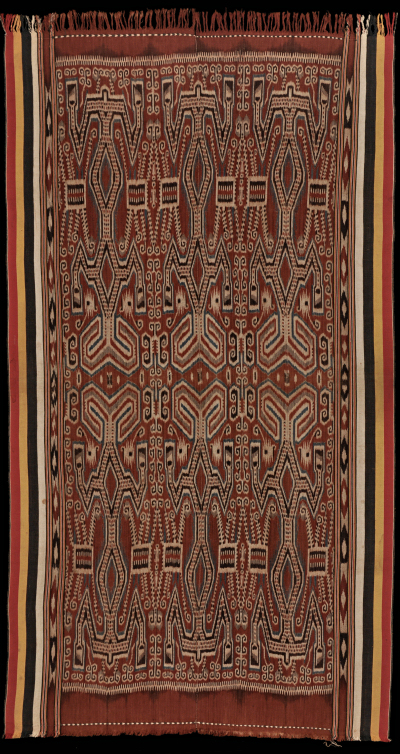| |
074 Borneo, Sarawak
Pua kumbu  
|
| Locale: | Iban Dayak, most likely from the Krian, a tributary of the Saratok neighbouring the Saribas. |
| Period: | Circa 1940 |
| Yarn: | Cotton, hand-spun, medium |
| Technique: | Warp ikat |
| Panels: | 2 |
| Size: | 133 x 243 cm (4' 4" x 7' 11") LW: 1.83 |
| Weight: | 1280 g (45.2 oz), 396 g/m2 (1.30 oz/ft2) |
| Design: | Pattern representing the great Gajah Meram, 'Broody Elephant', executed in saturated brick red, cream and light indigo. This powerful design, while rather rare, has a wide distribution and is highly regarded, suggesting great age. The Broody Elephant is a metaphor for the great warrior that the weaver wishes to pay homage to. The praise name is a metaphor for a warrior 'jealously guarding the severed head he has just taken.' (Heppell 2014:136). His head is always exaggerated to indicate that he returned home from battle with his head firmly secure on his body � in direct contrast to a decapitated head which is always shown as a tiny seed on a torso. Borders in pale yellow, red and black. To cite Ong (see below): 'The white and blue outline of the form gives it a glowing mystery that resembles a vision of an electrifying extra-terrestrial.' |
| Comment: | Very large old pua kumbu of powerful design. Excellent weaving. The plain coloured border stripes were done in triple-ply commercial yarn, probably to match the thickness of the double-ply hand spun yarn used for the field. Heavy cloth with sturdy, protective feeling. The fine black stripes along the selvedges are the hallmark of a very accomplished weaver who was given permission to use this mark in a dream. |
| Background: | Chapters on Borneo and Sarawak. |
| Exhibited: | Hong Kong University Museum and Art Gallery, 2017. |
| Published: | Ikat Textiles of the Indonesian Archipelago, 2018.
|
| Compare: | 001 038 075 123 140 |
| Sources: | Fraser-Lu, Handwoven Textiles. p.146, identifies main motif as representing engkaron, lizards. Traude Gavin in The Women's Warpath shows two similar cloths and identifies the motifs as crocodile pattern, buah buaya. See plates 28 and 29. We rely on Vernon Kedit's identification of the motif as Gajah Meram, his recognition of the stature of the weaver, and his qualification of the cloth as 'magnificent'. |
| |

©Peter ten Hoopen, 2025
All rights reserved.
|


